|
Riley car photographs / pictures in alphabetical order
If you would like your car to appear here please contact me with details.
Riley 9 h.p Mk IV (2 str.) tourer
Forerunner to the Ascot which is sometimes known as a Doctors Coupe or Golfers Coupe.
Riley Adelphi
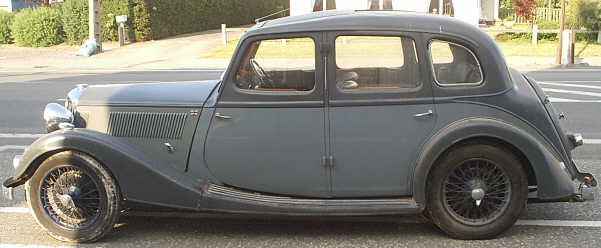 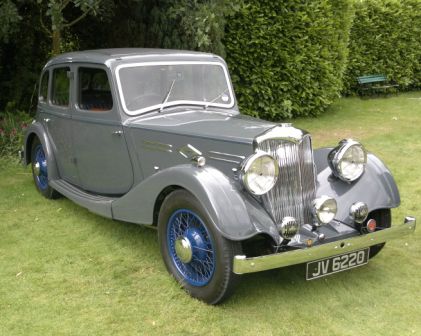
On the left owned by Guy Deneweth from Belgium 1937, chassis 27A6088, 1490 cc engine A6088. On the right - picture kindly sent by Charlie Clifford.
Autovia
For more information see my Autovia page.
A very nice 1961 BMC 1.5 at Goodwood 2004
The sucessor to the RMH Pathfinder, only around 2,000 Two-Point-Six were ever built and only about 16 are believed to survive.
A very nice 1964 4/72 seen at Broadlands Sept 04 reg 645MOU.
BMC Riley Elf
Here is a number plate not seen on many Elf's, this one is one of several working Riley in Sri Lanka. Mini's are popular in Sri Lanka, to look at the Mini owners Facebook site click here -
BMC Riley Kestrel
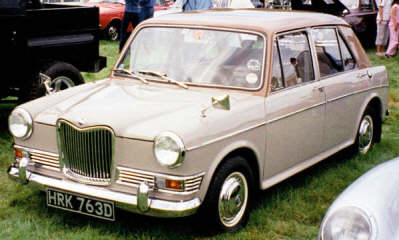 
EBAY CAR CHALLENGE GEARS UP WITH THE FINAL
THREE
Below - ebay recently invited amateur car restorers to take part in a challenge to restore their car using parts bought on ebay, the following press release explains all :- I have edited it to show just the Riley, follow the link at the end to read all about it.
eBay unveils the three classic restoration
projects to take part in the first ever eBay Car Challenge. A Volkswagen Beetle, Riley Kestrel 1300 and Mk3
Triumph GT6 will be transformed over the next three months using only parts and
accessories from eBay.
Hundreds of amateur restorers applied to take
part in the eBay Car Challenge with the chosen three receiving £4,000 each to
spend on eBay. The restorers will now
lavish all their attention on their vehicles in preparation for the final
reveal in July.
The oldest vehicle to receive some much-needed
TLC is a rare 1968 Riley Kestrel 1300, which once belonged to restorer Charlie
Renwick's great grandmother.
Unfortunately, the car has been sitting in a
garage for over 40 years and now needs some serious attention to ensure it
shines once again. "My great aunt and mum have fond memories of my great
grandmother driving this car around, so I hope to make them proud,"
explains the 25-year-old from Essex.
to view all the youtube video's search ebay car challenge
 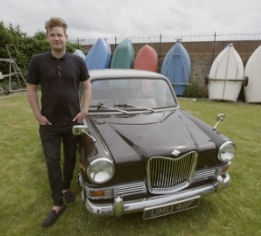
Above left - Charlie with his Kestrel before and right - after restoration
The Riley 9 Brooklands as described in "Collins Gem Guide" to "Sports Cars" published 1986 (therefore not sure of accuracy):-
This model became the epitome of the British sports car. It had a low-slung, rakish appearance with flared front wings. The first few cars were actually assembled at Brooklands by the firm Thomson & Taylor,
but later on, Riley took over production themselves. The engine, which
caused a sensation when it appeared, remained the basis of Riley models
until 1957. Developement work was undertaken by Parry-Thomas, the famous Welsh driver engineer. He was killed in 1927 while attempting the Land Speed Record, and subsequently Reid Railton took over.
Country of origin: Great Britain
Date: 1927
Engine: Straight four; pushrod ohv; twin Solex carburettors; 50bhp at 5,000rpm
Gears: four-speed manual
Capacity: 1,089cc
Bore & Stroke: 60.3 x 95.2mm
Maximum Speed: 130km/h (80mph)
Chassis:
Pressed steel side memembers, underslung at rear. Front and rear
suspension comprising of semi-elliptic leaf springs, friction dampers
Dimensions: Wheelbase 244cm (96in). Track 121 cm (45.5in)
Tyres: 11 x 68.6cm
Brakes: four-wheel drum
A beautiful Brooklands at the Le Mans classic in 2006, once owned by Whitney Straight. Picture kindly provide by it's present owner who took 2 years
to restored it after it had lain hidden in a garage for 40 years.
Another beautiful 1928 Brooklands, picture taken from an auction catalogue from 1991. One of only 93, once owned by Victor Gillow.
Below - An article from April 1952 "Model maker" magazine about the above Brooklands cars with pictures of GP17 PROTOTYPE PARADE No.36
THE BROOKLANDS RILEY
DESCRIBED BY G.H.DEASON ("Model Maker" volume 2 No.17).
Some
of the detail in this article is not entirely correct, particularly the
reference to the car GP17 once being owned by Whitney Straight, which it was
not. The present owner of the Whitney Straight car registration plate
GJ18 has well documented proof of this, so I am happy to put the record
straight.
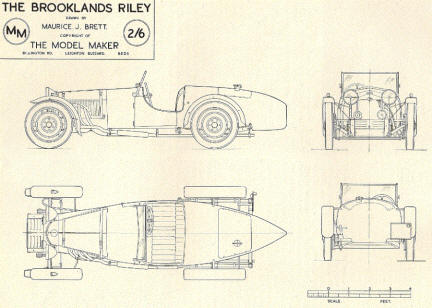
The Riley
Nine, apart from its general excellence as a normal motor car, can claim
with the M.G. and the smaller unblown Bugattis to have been the
"primary trainer" of more famous racing drivers than almost any other
car. When in 1927 the little Nine replaced the excellent, if somewhat
stodgy, s.v. models, the motor public was enchanted with its modern
lines, excellent road performance and manners, and its "silent third"
gearbox. Sundry gentlemen whose life work consisted of making motor cars
go faster than their designers intended that they should, however, were
already casting a speculative eye at the new power unit, with its
clever two-camshaft, high push-rod valve gear, and 90 deg. valves in
hemispherical cylinder heads, and sundry other features likely to lend
themselves to their craft.
Amongst these were
the uncrowned king of Brooklands, the late J.G. Parry Thomas, and Reid
Railton, and it was the former who commenced work on a Riley Nine
chassis with a view to producing a racing car. His tragic death at
Pendine the same year occurred before the enterprise was completed, but
the work was carried on by Reid Railton, who went on to produce the
first racing Nine, which immediately distinguished itself by winning its
first race on the Outer Circuit at 91.37 m.p.h.
Shortly
after this the car was put into limited production by the Riley
company, catalogued as the Speed Model, which to the best of my
recollection remained its official title during the four years of its
manufacture; to all and sundry, however, it has always been the
Brooklands Riley. The car was an immense and immediate success with
private owners, for not only was it that rare bird, an "off-the-peg"
racing car, but it was obviously capable of breaking the long domination
of the 1100 c.c. class by the French voiturettes, the most successful
of which had been the Salmsons and Amilcars. Names now famous in
motoring history began to be associated with the Riley, and amongst
drivers with already established reputations who drove the marque with
success were Sammy Davis, H.W.Purdy, Capt. G.E.T. Eyston, A.F. Ashby,
Cmdr. Whitcroft, Victor Gillow and, of course, the redoubtable Freddie
Dixon himself. Many more rose to fame from modest beginnings with this
safe and speedy little car, as I was given reason to remember when I was
introduced to the perfect little specimen which is the subject of my
photographs and this month's drawing, in that happy hunting ground of
exciting machinery, Chiltern Cars of Leighton Buzzard. The history of
GP17 had been traced, and it was found (incorrectly)
to be the car on which Whitney Straight, later to make a great name in
motor racing in a phenomenally short time, first essayed competition
driving, and which he drove at Shelsley Walsh before graduating to the
K3 Magnette and the big Maserati which gained him the hill record. The
little car is in virtually original condition, with the possible
exception of the front wings, which, at anyrate in the earlier models,
were longer, and swept back as far as the scuttle. My pictures, I fear,
are not as clever as they might be, my excuses being that within a
couple of minutes of taking them a brisk snow storm happened, and the
light matched the weather, whilst my rapidly advancing years must have
thinned my blood to the point when I find motoring of this calibre in
winter a perishing cold business, and chattering teeth are not conducive
to a steady camera hand. Nevertheless, in my brief acquaintance with
GP17, she proved to have lost none of her powers during the years that
have played havoc with my own.
The principal
structural features of the Brooklands Riley as distinct from the
standard model, are a considerably lower chassis of somewhat different
shape, which gave what was in its day an "all-time low" in seating
positions. It was said that you could place the palm of your hand on the
ground when normally seated, and other less printable, if more
picturesque, descriptions were applied to it also. The Riley radiator
was retained in a drastically cut-down form, the radiator cap being 31
in. from the ground. A pretty long tailed two-seater body held two
people side by side, provided that they left their heavy overcoats
behind, and full lighting equipment, a skimpy hood and a generous
windscreen, were standard fittings. Viewed from the side the early
models were if anything a trifle too long in the tail, and later years
produced a shortened version.
Since the car was
designed to conform to A.I.A.C.A. sports car regulations to enable it to
compete in catalogued sports car events, it was necessary that the
bolt-on wheels of the standard machine should be retained, to the great
discomfiture of drivers who had to carry out wheel changes during
hurried pit-stops, and all the Brooklands models had the six-stud fixing
as sold. The original tyre size was 27 x 4.40, although the more modern
19 x 4.50s are now fitted.
Twin Solex
carburetters and separate pipes to each exhaust port are features of the
engine, which gave some 50 b.h.p. at 5,000 r.p.m. in factory form. A
number of later "Plus" series cars were produced with four carburetters
bolted direct to the ports, with a common float chamber to each pair.
The Riley was one of the first cars to be sold with the now fashionable
"remote" gear lever, a tiny control placed centrally with the hand
brake. The instrument panel carries its row of modest dials across its
full width, and originally a rigid steering wheel was fitted, from the
centre of which protruded the hand throttle and ignition levers as
fitted to contemporary touring models. The fuel tank is in the tail,
with an external filler, the tail also housing the spare wheel.
A
number of these grand little cars are still performing with great zest
in club race meetings both here and abroad, to remind us that in their
heyday they were practically unbeatable in the 1100 class.
Long
distance Brooklands records fell to them in 1929. In the same year
G.E.T. Eyston won his class in the Irish G.P., and Sammy Davis scored
another class win in the Tourist Trophy, being the first unsupercharged
car home, irrespective of capacity. In the 1930 T.T., another class win
was chalked up, coupled with a class lap record, at 66.82 m.p.h. 1930
also saw Victor Gillow's hair-raising ride to victory at Phoenix Park in
the Irish G.P., in the car which subsequently passed into Freddie
Dixon's hands and achieved immortality as the "Red Mongrel". In the
course of his astonishing drive at Phoenix Park, Gillow broke the
unlimited lap record at 76.7 m.p.h., despite the presence of nineteen
supercharged opponents. Truly the Brooklands Riley has earned its place
among classic British sports cars of the past.
Below
- Purposeful front end. The low radiator is emphasised here by the
temporary absence of headlamps, which are normally fitted to this model.
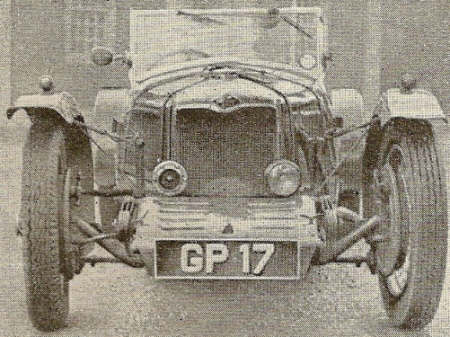
Below - Details of the four branch exhaust system, louvres, brake back-plates and wing mountings.
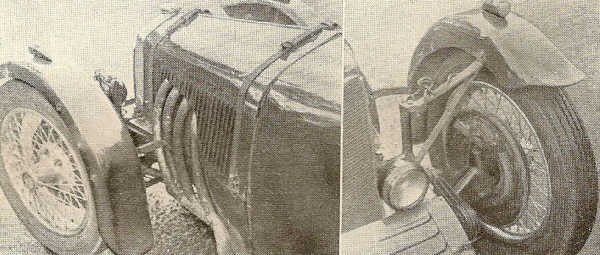
Below
- One of the trimmest models of the late Vintage period, the Riley is
low by modern sports-car standards. Note the doors extending into the
scuttle.
 
Below - A familiar view in the early 'thirties. The additional number plate makes doubly sure that the law is complied with.

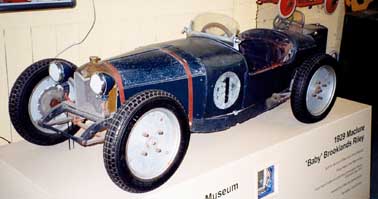 
I am reliably informed this is a Dixon Riley once registered as VC8303
This 1937
Falcon returned to the UK after a lifetime in Australia in 2000, given a period
English number plate by DVLC after providing the necessary paperwork to
prove its authenticity. Shown here at the White Horse, Ampfield in
Hampshire.
Riley Forecar
Riley Gamecock
1932 Gamecock, Chassis no.6016563. Still warm after succesfully passing its MOT 25.5.01 in Old Shanklin, Isle of Wight.
Note
the non standard exhaust, the original running boards and wings have
been removed and non standard mudguards fitted. This was done before the
present owner bought it in 1957. Still there in 2008 when we visited
again but has since been sold, the IOW owner said in 2017 when I went looking for it that he was getting too old to crawl around under it anymore.
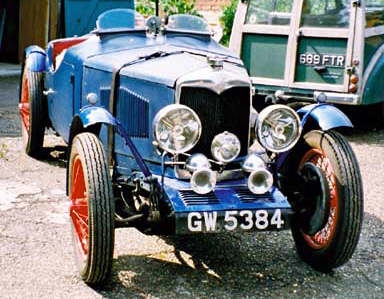 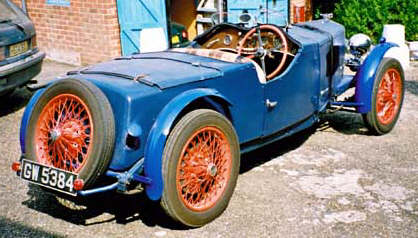 
Riley Imp
First
seen at the 1933 October motor show in what today may be described as a
concept car, the first prototype was registered in March 1934.
About
115 were produced over a period of 18 months although precise figures
will never be known due to the companies records being destroyed in bombing raids on Coventry during WWII.
A 2008 book
"The Riley Imp", Histories and Profiles by John Gathercole gives an in
depth history of many of the cars and all things Imp.
The Riley Imp as described in "Collins Gem Guide" to "Sports Cars" published 1986 (therefore not sure of accuracy):-
The
final variant of the original Riley Nine, the Imp was a very neat and
pretty car with rounded tail and flared wings. These racy styling
characteristics were belied by its performance which did not quite live
up to its appearance. It was popular for rallying but lacked the power
for racing.
Country of origin: Great Britain
Date: 1935
Engine: Straight four; pushrod ohv; twin SU carburettors; 41bhp at 5,000rpm
Gears: four-speed manual; optional "preselectagear" transmission
Capacity: 1,089cc
Bore & Stroke: 60.3 x 95.2mm
Maximum Speed: 115km/h (70mph)
Chassis:
Box section side members with cross-bracing, underslung at rear. Front
and rear suspension by semi-elliptic leaf springs, friction dampers
Dimensions: Wheelbase 230cm (90.5in). Track 121 cm (47.5in)
Brakes: four-wheel drum
Body: two-seater; fold-down windscreen
Below, another Prototype Parade, this time from "Model Cars" June 1964, followed by more recent pictures and description from an auction.
All of the Prototype Parade aricles can be found here - Prototype Parade , only 2 Riley related in the whole series.
(I will add that the other article above about the Brooklands Riley has some errors so beware of the accuracy of this one)
PROTOTYPE PARADE No.
146
1935 RILEY IMP
DESCRIBED BY
A. RUSSELL BLACK (
Model cars June 1964)
Every once in a while the automobile industry produces what
enthusiasts might refer to as a masterpiece of engineering but they, being
perhaps a little biased, tend to exaggerate a trifle. Still, I do not think that there is any doubt
that in their own way these cars are “jewels” and often the case is that they
are a good investment if one is prepared to wait until such times as their
value has in many cases, tripled itself.
The opinion of many, and I am not one to disagree, is that the Riley Imp
falls into this category. Perhaps I
should make it clear that it is not the present Imp that I refer to but the
model produced in 1935.
The Riley Motor Company had been founded on cars of a
sporting nature and with the introduction of the “Nine” in 1926 they paved the
way for enthusiasts who were seeking a suitable mount to modify for
racing. The most successful was without
a doubt the car produced by the two famous men of the thirties, substantiating
the old saying “two heads are better than one.”
These two personalities were of course Parry Thomas and Reid Railton who
performed drastic operations on the Nine and when finished it appeared as a low
slung racing machine which could be pushed along at a fair speed as the records
show. This little car was not long in
making a name for itself and in fact won the first race it was entered
for. The company of Thomson and Taylor,
who were responsible for many of the big land speed record cars, decided to
produce this car in limited quantity and was built at their Brooklands works
and became known as the Riley Brooklands Nine.
The success of this little car in the hands of many exciting
names amongst whom the one F. W. Dixon stands out, fired the Riley Motor
Company into producing this car themselves under the name of “Speed Model” but
there was a snag that in fact was not cleared until the production of their
next car. The Brooklands was in fact a
car developed for racing and was far too potent a machine for the open road and
it was this reason that the Riley Company produced the Imp to cater for the
average enthusiast.
The new car certainly had “impish” lines as its name
suggests and even today it has the true appeal of the sports car line. Certainly today we must face the fact that
comfort comes first and that the sports cars are designed with this in mind,
but personally I feel that it destroys the line when taken too far. The powerplant of the Imp was the ever
faithful Nine which had a capacity of 1,089 c.c. with a bore and stroke of 60.3
x 95.2 mm. The overhead valves were
operated by high set camshafts, which in turn operated short pushrods on each
side of the cylinder block.
The bodywork of the car was made from alloy and this may
account for the number still in existence today. Truly an enthusiast’s car, it is now very
difficult to find one that is exactly stock, as the Americans put it, as the
owners have altered their cars to suit themselves. The accompanying photographs show this quite
clearly as the mudguard have been cut below the front line of the door and the
portion between this point and the rear mudguard has been removed. The dash too has extras but the owner stated
that the car was now in a state of restoration and all would be as near to
original in about a year’s time.
I do not think that there is a shadow of a doubt that the
1935 Riley Imp was one of the most exciting sports cars in the 1,100 c.c. class
of the thirties. The few examples that I
have the opportunity of examining have all been in excellent condition apart
from a few alterations and the unfortunate bump that the one shown in the
photographs had to the rear wing, so it does say a lot for the quality of these
little cars.
Below - details of auction, again not sure of accuracy.
1935 Riley 9hp Imp Sports Two-seater
Registration no. OW 7859 Chassis no. 6027359 Engine no.
55514 (see below)
Sold for £ 49,450 (US$ 65,154) inc. premium 5 Sep 2015,
13:00 BST
At Beaulieu, National Motor Museum, Present family ownership
since 1964.
Development work on a standard Riley chassis by
engineers/drivers J G Parry Thomas and Reid Railton so inspired the Riley Board
that they sanctioned the designing and building of a two-seater sports car,
designated the 'Brooklands'. It featured the well tried and tested
four-cylinder, pushrod-operated, twin camshaft engine, displacing 1,087cc, and
a lowered chassis and was to dominate the 1100cc class in international
competition in the late 1920s and into the next decade. It was from this
competition experience that the design of Riley's sporting two-seater Imp,
launched in 1933, was developed, a light sports car built on a shortened 7ft
6in wheelbase chassis with appealing styling from every aspect.
This Imp, was first registered with Southampton County
Borough Council on 7th November 1935 and, although it’s very early history is
not recorded, it is known to have been trialled pre-war by one J.P.Hill.
John Gathercole's standard work, 'The Riley Imp.'
illustrates OW 7859 tackling the Adderstone Hairpin on the London-Edinburgh
Trial of 1938 and a letter from A.H.Hill in the Riley Register magazine in 1988
refers to the car being "well and truly tested in MCC events" in
1938, taking part in the London-Edinburgh, Lands End and Exeter Trials, being
campaigned at Donington, Prescott and Wetherby, and winning the prestigious RMC
Ski Lady Trophy that year. In 1959 it was owned by D.Webster of Lytham St.Annes
and in 1964 it was bought by Professor L.R.Moore for his son, in whose
ownership it remained until his recent death. In 1964 the recorded mileage was
54,000 miles
A letter from D.Webster in 1964 records all work undertaken
and refers to the fitting of Girling mechanical brakes. In 1964 this car was
selected by Model Cars Magazine for their Prototype Parade Plan no. 146 which
featured a fine line drawing by A. Russell Black. This drawing clearly shows
the MPH style spare wheel cover which the car retains, a feature which Imp
historian Gathercole states is common to only two other recorded Imps.
This wonderful restoration project, in the present family
ownership for 51 years, has been off the road for many years and has been the
subject of a long, ongoing, but never completed restoration. It appears to be
substantially original and complete in all major respects although it should be
noted that the original engine (No. 55514) has at some stage been replaced with
a Riley 9hp engine of similar vintage – perhaps the outcome of enthusiastic
trialling pre-war. The mechanical condition of this manual gearbox car is
unknown. The car comes with a good history file including an old buff logbook
and Swansea V5C document, maintenance and instruction books, various
correspondence and other related literature.
John Gathercole's book can be seen on my "Book's" page - Books
From Practical Classics 1997 - (therefore not sure of accuracy):-
The
Riley Kestrel offered performance and handling of a high order for its
day and had few competitors other than the wide range of models offered
by Riley themselves.
Perhaps the most
outstanding feature of its 9hp, two-bearing engine is its efficient
cylinder head. The combustion chambers are hemispherical and the twin
camshafts in the top of the cylinder block operate the overhead valves
by short pushrods.
Available in single and
twin carburettor (special series) form, this engine was fitted to such
models as the Monaco saloon, Lynx tourer, Imp sports and the Merlin and
Kestrel saloons. The last named were produced in 9hp form over
1933-'36.
Kestrels made in 1933/'34 were
fitted with the four-speed helical gearboxes, and later models featured
Wilson four-speed pre-selector gearboxes and centrifugal clutches.
Although these brought the penalty of added weight, they did make gear
changes easier and virtually instantaneous.
Low
weight, aerodynamic bodywork and good handling characteristics made
Riley outstanding performers in the 1930s, but their ambitious racing
programme and big model range led to financial problems. Riley were
taken over by Lord Nuffield in 1938 and sold to Morris Motors for £1 -
sad end to a company respected for its innovative design, high quality
and sporting successes.
Left - Big 4 Kestrel, picture supplied by the owner Calum Hamilton. Right - 1936 12/4 light six DMK56, once owned by my brother Howard Higgs in the 1960's.
Right hand picture from Charlie Clifford.
Riley Lynx

12/4 Lynx (Photo kindly supplied by Peter Morrell).
Left - Mentone and right - 1934 Mentone available for weddings (search nostalgic car hire)
Riley Merlin 9
Picture supplied by owner Mike Mc Nerney 2016
Riley Monaco
Below - My 1932 Monaco around 1968 just before I sold it - it is now a special, here are some of my "then" and the present owners "now" pictures.
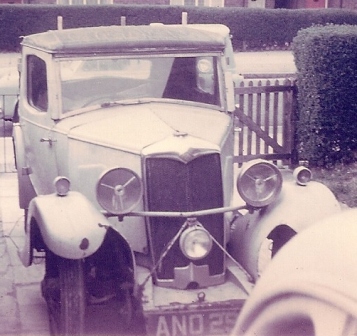 
Below - 1933 Monaco brought from Scotland to Helston in Cornwal 2003, now owned by Tony Barfield.
 
Below - an early fabric covered Monaco, picture from Charlie Clifford.
Riley MPH
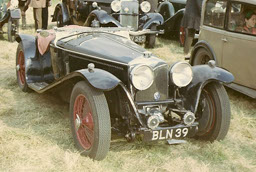

Photographed at Goodwood July 06 a 1923 11/40 2 seater sports "Redwing" although this one has not got red wings!
Riley RM A - H
Announced
in late 1945 the Riley 1.5 was initially built at the old Riley works
at Foleshill, Coventry. In 1949 production moved to the M.G. factory at
Abingdon.
A larger engined (2.5) model soon followed in 1946 when the models became known as the RMA for the 1.5 and RMB for the 2.5.
In
1949 the RMC 3 seater roadster and the RMD 4 seater drophead coupe were
made based on the RMB chassis, aimed at the American market they did
not sell well so production ceased after only about 500 of each making
them the most valuable today.
1952 saw both RMA and RMB models
updated to RME and RMF, the RMG never materialise and the last in the
line the RMH Pathfinder ceased production in 1957.
Production
numbers - RMA - 10504 from 1945 - 1952, RMB - 6900 from 1946 - 1952,
RMC - 507 from 1948 - 1951, RMD - 502 from 1949 - 1951, RME - 2446 from
1952 - 1955, RMF - 1050 from 1952 - 1953 and RMH Pathfinder - 5536 from
1953 - 1957.
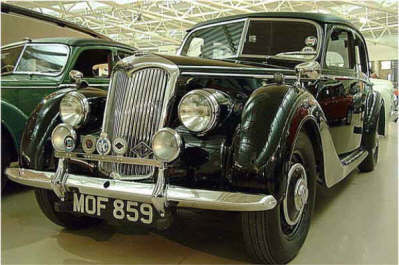
1950 RMB seen in Australia 2005
RMC drophead coupe
A lovely RMD I saw advertised for sale
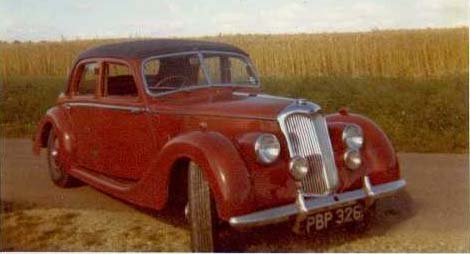
1953 RME 1.5 shown here in 1970 ish. It used to belong to Michael
Payne. It cost £50.00. To quote Michael "it was good fun at the time
..but a lot of time under the bonnet". I think we can all agree there!
1953 RMF 2.5 NYL478 shown here at the White Horse, Ampfield, Hampshire. June 2001
What a fantastic line up of Riley Police cars, they were very popular with many forces.
RMH Pathfinder, this is what was said about it (therefore not sure of accuracy) :- RILEY - Stand 125 Earls Court 1953
Plenty of room and very high speed is offered in the new Riley Pathfinder Saloon.
Riley
has exhibited many exciting new models at past London Motor
Shows-remember the sensation the new Nine saloon caused in 1926, and
this time it holds our attention with the new Pathfinder saloon, a car,
we trust, which doesn't really tend to run onto the pavement.
This
fine saloon, spacious and stylish, employs the 2 1/2-litre four
cylinder push-rod but hemispherical head Riley engine to good purpose,
for the compression-ratio has been increased to 7.25 to 1, resulting in a
power output of 102 b.h.p., which gives a road speed of over 100 m.p.h.
under, as the maker's have it, "ideal conditions."
Here
then is another family saloon capable of achieving the once so-magic"
century" or "ton." This, moreover, with a back-axle ratio of 5.125 to 1.
It costs a basic £915
In addition to this handsome
and purposeful substitution for the former 2 1/2-litre, the
well-established and truly good-looking 55 b.h.p. 1 1/2-litre Riley
saloon has been still further improved in looks. It costs a basic £850.
Riley Motors, Ltd., Cowley, Oxford.
Above - 12/4 special owned by Dirk Libeert in Belgium (2007), an example of one of the many specials made from original Riley parts.
Above - T.T. Sprite replica, picture from Charlie Clifford.
Above - Picture of one of the H.A.R. Specials and below information, picture and information from Charlie Clifford.
HORACE RICHARDS AND THE H.A.R. - SOME NOTES
Many members will remember the
electrifying performances put up by a very fast Brooklands in the hands of Peter Binns and (before Peter had
the car) when it was driven
by Austen Nurse. 'What one tends to forget, however, is that (earlier still) the car had been
breathed on by Horace Richards who had himself competed
with it-not without success.
Horace ran a garage in Birmingham, and
devoted a considerable amount of time and energy to various aspects of motor sport. In 1952—spurred on,
no doubt, by his campaign
with the Brooklands—he produced an entirely new car for the then " Formula 2"
calling it by his initials—"H.A.R." In the 'Racing
Car Pocket Book' Denis Jenkinson wrote:
"Horace Richards built his own tubular chassis, with
independent suspension to all four wheels, and installed the 2 litre Riley
engine for 1952/3 Formula 2 racing. A nicely made:, and well proportioned car
..."
The opinion expressed in the last
sentence is heartily endorsed by the Editor who can
remember Horace performing with the car at Goodwood.
In March, 1952, The Autocar featured
this car in its series "Interesting Competition
Cars," and in their article they gave technical details as follows.
" The frame is a welded tubular
structure consisting of two perfectly straight chrome molybdenum steel tubes, 3in. in diameter and 17-gauge, lying parallel with their centre's about
2ft. apart, and braced laterally by three main cross members. These are tubes of the same
diameter as the longitudinals,
strategically placed to take care of the torsional loads imposed by the front
and rear suspension. The centre one is bowed slightly downwards and supports
the rear of the power unit. In addition there are two two-inch cross tubes, one each at the extreme
ends to carry the radiator block and tail fuel tank. Sheet metal box section pedestals are
built up on each side at front and rear to provide a mounting point for the
upper suspension arms, the same method being used for the forward engine bearers, which are designed to accommodate three alternative engine units. The frame weighs only
801b.
Independent suspension at both front
and rear is through unequal length wishbones controlled by Salter laminated-blade torsion bars. Levers on
the ends of these are
connected by links to levers of the same length formed integrally with the light alloy lower wishbones,
which pivot on their own bearings
on the frame. The torsion bars lie inside the main frame tubes and the abutment at their fixed ends is
adjustable for trimming the level of the car. Girling piston-type dampers form the pivot
point of the shorter upper wishbones.
This much of the system is common to
each wheel, the outer ends of the wishbones at the front being connected by forgings, machined all over
and polished, which carry
separate kingpins upon which pivot standard Riley stub
axles.
Riley rear hubs are bolted to light alloy carriers
whose central bosses house
additional bearings for the short axle shafts. Modified Girling hydraulic brakes having magnesium alloy shoes
carried on similar back plates operate in centrifugally cast iron liners in magnesium
alloy drums, the hand brake being
mechanically operated and separate from the hydraulic system. The tunnel of the rack and pinion steering
gear is mounted on brackets welded to the front main cross tube, and the column has two rubber-enclosed
universal joints which
give clearance for any of the three available engines. The ratio gives 2;I: turns from lock to lock.
Universally jointed half-shafts transmit the drive to each
rear wheel from
a plain differential housed in an Elektron casing having integrally cast transverse arms which bolt on to faces welded to
the frame tubes. On the front of the Elektron nosepiece a separate housing
contains a pair of spur gears
disposed one above the other so that the transmission line and seat level are lowered considerably. By transposing
various gears in this housing, six
different final drive ratios are available. Between this assembly and the tail
of the gear box is a short universally jointed propeller shaft running in a sheet metal tunnel, the mountings for which, to
guard against trouble in the event of
failure of the shaft completely encircle both ends. In order to upset as little as possible the weight
distribution of the car, which is approximately
50-50, the total fuel stowage is carried in three welded light alloy tanks, 17 gallons in the tail and 71 gallons
in each wing tank on either side of
the driving seat. An entirely separate feed allows fuel to be used first from the tail tank. Each tank has its light
alloy quick-action filler cap and blow-off valves set to 21 lb. A hand
operated pump supplies the pressure.
Made of
Duralumin in two main portions, scuttle and tail, the body has extremely pleasing contours formed
over its steel tube frame, and is readily demountable from the chassis. The
hoops of the framework terminate in small feet which bolt on to light
sheet brackets welded to the chassis tubes. Louvered fairings flank the one-piece bonnet panel,
which is secured by stout spring-loaded straps recessed to lie flush with the
surface.
A nose
cowling and a full-length undertray complete the body parts, though additional fairing are
contemplated over those parts of the suspension left exposed at present. A fixed
screen of Perspex is flanked by twin rear view mirrors. Instruments are
reduced to a rev counter, oil and air pressure and oil and water temperature gauges.
Centre-lock wheels are shod with 5.00-17in. tyres at the
front and 5.25- 18in. rear; the track is 4ft. 2in. and wheelbase 8ft. With
1,100 c.c. engine the
weight is about 81 cwt."
Sometime
after the death of Horace Richards the Riley engined H.A.R.* was bought (but never raced) by
Jack McEwen (of ex Lady Mary Grosvenor Sprite fame). Jack tells us that
he obtained the car from a Mr. Bettinson who had bought it from A. L.
Healey—the man who had taken over the Richards Garage. Bettinson had
been fortunate in obtaining with the car one of the original 2 litre 6 cyl. Riley engines with
E.R.A. crank and rods.
Jack sold
the car to Colin Clifford who did quite an amount of work on it, and turned it out in the
same immaculate style as all his other cars. He brought it to a Coventry Rally
a few years ago, and the sight and the sound of it were among the highlights of the day.
Like
others before him, however, Colin found that the car—although beautifully made—was not really
competitive in the classes in which it was eligible. It has now passed out of his possession.
It is worth mentioning, in conclusion, that there were rumors
of a further
H.A.R. under construction. This was, so we understand, a 'pipe- dream ' of a car with a ladder
type chassis, independent suspension all round, and a 16 litre de Haviland
Chipmunk' engine. Nothing whatever to do with Rileys, but interesting all the same.
* There was a second H.A.R.. but although having a similar chassis it was fitted with a Jaguar engine, and is
of little interest to the Riley Register.
The Riley Sprite as described in "Collins Gem Guide" to "Sports Cars" published 1986 (therefore not sure of accuracy):-
The
engine of this handsome car was an enlarged version of the famous
four-cylinder Nine engine, while the rest of the car was a direct
descendent of the Riley MPH two-seater. The chassis was basically the
same as in the MPH, with the addition of Girling brakes; the bodywork
was extensively restyled, with elegant, curving wings and an unusual
radiator cowling, with its "fencers mask" shape
Country of origin: Great Britain
Date: 1934
Engine: Straight four; pushrod ohv; twin carburettors; 61bhp at 5,000rpm
Gears: four-speed manual; optional four-speed pre-selector
Capacity: 1,496cc
Bore & Stroke: 69 x 100mm
Maximum Speed: 140km/h (85mph)
Chassis:
Boxed-section pressed steel side members, underslung at rear. Front
and rear suspension comprising of semi-elliptic leaf springs, friction
dampers
Dimensions: Wheelbase 248cm (97.5in). Track 122 cm (48in)
Brakes: four-wheel rod operated Girling drum
Above - Belgium registered Sprite, photo from Pete Morrell and the rear end of a 37 Sprite under cover at the St Austell Motor Museum (before it closed).
Above centre - A beautiful reproduction flanked by picures of 2 of the original cars, of one of the three produced for the French Riley distributors Eudel et companie, Jean Eudel and and Guy Lapchin were close personal friends, they pooled resources to create a racing team "Ecurie Eudel" which used Sprite chassis and streamlined bodies designed by George Paulin and built by the noted coachbuilder Maurice Pourtot.
Riley 1904 Tricar
Riley V Twin

Left - 1907 9HP V Twin at the Heritage Motor Centre, right - 1908 2 1/4 ltr. V-Twin, picture from Charlie Clifford.
Riley Winchester
14/6 On show at Goodwood September 2018
|
|
|